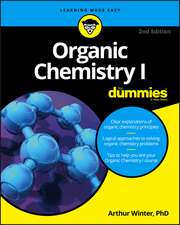Organic Spectroscopy
Autor Lal Dhar Singh Yadaven Limba Engleză Hardback – 9 dec 2004
This book provides:
-A logical, comprehensive, lucid and accurate presentation, thus making it easy to understand even through self-study;
-Theoretical aspects of spectral techniques necessary for the interpretation of spectra;
-Salient features of instrumentation involved in spectroscopic methods;
-Useful spectral data in the form of tables, charts and figures;
-Examples of spectra to familiarize the reader;
-Many varied problems to help build competence ad confidence;
-A separate chapter on ‘spectroscopic solutions of structural problems’ to emphasize the utility of spectroscopy.
Organic Spectroscopy is an invaluable reference for the interpretation of various spectra. It can be used as a basic text for undergraduate and postgraduate students of spectroscopy as well as a practical resource by research chemists. The book will be of interest to chemists and analysts in academia and industry, especially those engaged in the synthesis and analysis of organic compounds including drugs, drug intermediates, agrochemicals, polymers and dyes.
Preț: 761.24 lei
Preț vechi: 928.34 lei
-18% Nou
Puncte Express: 1142
Preț estimativ în valută:
145.67€ • 150.28$ • 121.56£
145.67€ • 150.28$ • 121.56£
Carte tipărită la comandă
Livrare economică 26 martie-09 aprilie
Preluare comenzi: 021 569.72.76
Specificații
ISBN-13: 9781402025747
ISBN-10: 1402025742
Pagini: 340
Ilustrații: X, 324 p.
Dimensiuni: 155 x 235 x 24 mm
Greutate: 1.41 kg
Ediția:2005
Editura: SPRINGER NETHERLANDS
Colecția Springer
Locul publicării:Dordrecht, Netherlands
ISBN-10: 1402025742
Pagini: 340
Ilustrații: X, 324 p.
Dimensiuni: 155 x 235 x 24 mm
Greutate: 1.41 kg
Ediția:2005
Editura: SPRINGER NETHERLANDS
Colecția Springer
Locul publicării:Dordrecht, Netherlands
Public țintă
ResearchCuprins
1. Introduction to Spectroscopy (Spectrometry).- 2. Ultraviolet (UV) and Visible Spectroscopy.- 3. Infrared (IR) Spectroscopy.- 4. Raman Spectroscopy.- 5. Proton Nuclear Magnetic Resonance (PMR or 1H NMR) Spectroscopy.- 6. 13C NMR Spectroscopy.- 7. Electron Spin Resonance (ESR) Spectroscopy.- 8. Mass Spectroscopy (MS).- 9. Spectroscopic Solutions of Structural Problems.- Answers to Problems.
Notă biografică
L.D.S. Yadav is currently Professor in the Department of Chemistry, University of Allahabad, India.
Textul de pe ultima copertă
Organic Spectroscopy presents the derivation of structural information from UV, IR, Raman, 1H NMR, 13C NMR, Mass and ESR spectral data in such a way that stimulates interest of students and researchers alike. The application of spectroscopy for structure determination and analysis has seen phenomenal growth and is now an integral part of Organic Chemistry courses.
This book provides:
A logical, comprehensive, lucid and accurate presentation, thus making it easy to understand even through self-study;
Theoretical aspects of spectral techniques necessary for the interpretation of spectra;
Salient features of instrumentation involved in spectroscopic methods;
Useful spectral data in the form of tables, charts and figures;
Examples of spectra to familiarize the reader;
Many varied problems to help build competence ad confidence;
A separate chapter on ‘spectroscopic solutions of structural problems’ to emphasize the utility of spectroscopy.
Organic Spectroscopy is an invaluable reference for the interpretation of various spectra. It can be used as a basic text for undergraduate and postgraduate students of spectroscopy as well as a practical resource by research chemists. The book will be of interest to chemists and analysts in academia and industry, especially those engaged in the synthesis and analysis of organic compounds including drugs, drug intermediates, agrochemicals, polymers and dyes.
L.D.S. Yadav is currently Professor in the Department of Chemistry, University of Allahabad, India.
This book provides:
A logical, comprehensive, lucid and accurate presentation, thus making it easy to understand even through self-study;
Theoretical aspects of spectral techniques necessary for the interpretation of spectra;
Salient features of instrumentation involved in spectroscopic methods;
Useful spectral data in the form of tables, charts and figures;
Examples of spectra to familiarize the reader;
Many varied problems to help build competence ad confidence;
A separate chapter on ‘spectroscopic solutions of structural problems’ to emphasize the utility of spectroscopy.
Organic Spectroscopy is an invaluable reference for the interpretation of various spectra. It can be used as a basic text for undergraduate and postgraduate students of spectroscopy as well as a practical resource by research chemists. The book will be of interest to chemists and analysts in academia and industry, especially those engaged in the synthesis and analysis of organic compounds including drugs, drug intermediates, agrochemicals, polymers and dyes.
L.D.S. Yadav is currently Professor in the Department of Chemistry, University of Allahabad, India.
Caracteristici
An invaluable reference for the interpretation of various spectra






